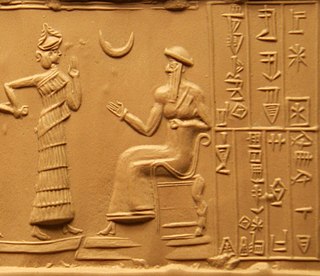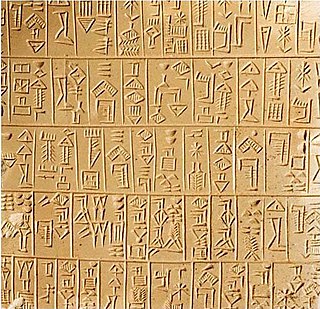Related Research Articles

Ur-Nammu founded the Sumerian Third Dynasty of Ur, in southern Mesopotamia, following several centuries of Akkadian and Gutian rule. His main achievement was state-building, and Ur-Nammu is chiefly remembered today for his legal code, the Code of Ur-Nammu, the oldest known surviving example in the world. He held the titles of "King of Ur, and King of Sumer and Akkad".

Shulgi of Ur was the second king of the Third Dynasty of Ur. He reigned for 48 years, from c. 2094 – c. 2046 BC or possibly c. 2030 – 1982 BC. His accomplishments include the completion of construction of the Great Ziggurat of Ur, begun by his father Ur-Nammu. On his inscriptions, he took the titles "King of Ur", "King of Sumer and Akkad" and "King of the four corners of the universe". He used the symbol for divinity before his name, marking his apotheosis, from the 23rd year of his reign.

Ninsun was a Mesopotamian goddess. She is best known as the mother of the hero Gilgamesh and wife of deified legendary king Lugalbanda, and appears in this role in most versions of the Epic of Gilgamesh. She was associated with Uruk, where she lives in this composition, but she was also worshiped in other cities of ancient Mesopotamia, such as Nippur and Ur, and her main cult center was the settlement KI.KALki.

Ištaran was a Mesopotamian god who was the tutelary deity of the city of Der, a Sumerian city state positioned east of the Tigris on the border between Sumer and Elam. It is known that he was a judge deity, and his position in the Mesopotamian pantheon was most likely high, but much about his character remains uncertain. He was associated with snakes, especially with the snake god Nirah, and it is possible that he could be depicted in a partially or fully serpentine form himself.

Nanaya was a Mesopotamian goddess of love, closely associated with Inanna.

Ninshubur was the sukkal (vizier) of the goddess Inanna in Sumerian mythology. Ninshubur also served as the vizier of the sky god An and by extension as the messenger of the assembly of the gods, similar to Greek Hermes or Iris. Her name means "Queen of servants" or "Queen of Subartu" in Sumerian.

Allani, also known under the Akkadian name Allatu was the Hurrian goddess of the underworld, incorporated into Hittite and Mesopotamian pantheons as well.

Sumerian literature constitutes the earliest known corpus of recorded literature, including the religious writings and other traditional stories maintained by the Sumerian civilization and largely preserved by the later Akkadian and Babylonian empires. These records were written in the Sumerian language in the 18th and 17th Centuries BC during the Middle Bronze Age.

Geshtinanna was a Mesopotamian goddess best known due to her role in myths about the death of Dumuzi, her brother. It is not certain what functions did she fulfill in the Mesopotamian pantheon, though her association with the scribal arts and dream interpretation is well attested. She could serve as a scribe in the underworld, where according to the myth Inanna's Descent she had to reside for a half of each year in place of her brother.

Bala, Sumerian for "exchange", is the method by which the Ur III dynasty of Mesopotamia collected goods such as livestock, grain, labor and craft products from its provinces. Individuals of all rank were expected to contribute to this system. These taxes were used to fund building projects within the kingdom such as the building of canals which were vital in this area because the agriculture in this area was irrigated by water from the Tigris and Euphrates rivers. Those projects were built by Gurush/Geme (Sumerian), men and women workers respectively, paid using goods collected from the tax system. The provinces in the Ur III Empire such as Girsu, Umma and Lagash contributed materials according to the nature of goods they produced, their size and the amount of goods they could produce. For instance Girsu was a rich source of grain and would provide grain to the bala system whereas Umma was a source of other goods such as leather, reed, and wood. The central state also provided protection to the provinces as a means of protecting the resources while in transit as well as the cities from being overrun by raiders.

King of Sumer and Akkad was a royal title in Ancient Mesopotamia combining the titles of "King of Akkad", the ruling title held by the monarchs of the Akkadian Empire with the title of "King of Sumer". The title simultaneously laid a claim on the legacy and glory of the ancient empire that had been founded by Sargon of Akkad and expressed a claim to rule the entirety of lower Mesopotamia. Despite both of the titles "King of Sumer" and "King of Akkad" having been used by the Akkadian kings, the title was not introduced in its combined form until the reign of the Neo-Sumerian king Ur-Nammu, who created it in an effort to unify the southern and northern parts of lower Mesopotamia under his rule. The older Akkadian kings themselves might have been against linking Sumer and Akkad in such a way.

Nimintabba was a Goddess of Sumer.She is thought to have been a local deity of the city of Ur, as her only known temple was located there. Her worship was particularly associated with king Shulgi, and there are no previous attestations of her.

Apil-kin, was a ruler of the city of Mari, northern Mesopotamia, after the fall of the Akkadian Empire c. 2126-2091 BCE. He was a son of Ishgum-Addu, and ruled 35 years, according to the Shakkanakku Dynasty List. He had two sons, who succeeded him in turn: Ili-Ishar and Tura-Dagan.

Sukkal was a term which could denote both a type of official and a class of deities in ancient Mesopotamia. The historical sukkals were responsible for overseeing the execution of various commands of the kings and acted as diplomatic envoys and translators for foreign dignitaties. The deities referred to as sukkals fulfilled a similar role in mythology, acting as servants, advisors and envoys of the main gods of the Mesopotamian pantheon, such as Enlil or Inanna. The best known sukkal is the goddess Ninshubur. In art, they were depicted carrying staffs, most likely understood as their attribute. They could function as intercessory deities, believed to mediate between worshipers and the major gods.
Puzrish-Dagan is an important archaeological site in Al-Qādisiyyah Governorate (Iraq). It is best-known for the thousands of clay tablets that are known to have come from the site through looting during the early twentieth century.

Belet Nagar was the tutelary goddess of the ancient Syrian city Nagar. She was also worshiped by the Hurrians and in Mesopotamia. She was connected with kingship, but much about her role in the religions of ancient Near East remains uncertain.

Annunitum (Anunītu) was a Mesopotamian goddess of war. While initially she functioned as an epithet of Ishtar, she started to develop into a separate deity in the final years of the Sargonic period and through the Ur III period.
Idlurugu or Id (dÍD) was a Mesopotamian god regarded as both a river deity and a divine judge. He was the personification of a type of trial by ordeal, which shared its name with him.
Taram-Uram was a king's daughter and queen at the end of the third millenium BC. She was the daughter of the king of Mari, Apil-kin and the wife of Shulgi, second king of the Third Dynasty of Ur. The marriage was most likely arranged by Ur-Nammu, father of Shulgi. When coming to Ur she must have changed name. Her birth name is unknown. She was most likely the principal wife of the king in the first years of his reign and might even be the mother of his son and successor Amar-Sin. The latter made death offerings to her father.
Ea-niša was a lesser wife of Shulgi, king of the Third Dynasty of Ur, at the end of the third millennium BC. Ea-niša is known from a high number of sources making it possible to reconstruct to a certain extend her life.
References
- ↑ T. M. Sharlach: An Ox of One's Own, Royal Wives and Religion at the Court of the Third Dynasty of Ur, Walter de Gruyter GmbH, Berlin/Boston 2017, ISBN 978-1-5015-1447-0, 116-117
- ↑ Rita P. Wrightː Gendered Relations and the UR III Dynasty, inː Diane Bolger (ed.)ː Gender Through Time in the Ancient Near East, Plymouth, ISBN 978-07591-1092-2, p. 265
- ↑ T. M. Sharlach: An Ox of One's Own, Royal Wives and Religion at the Court of the Third Dynasty of Ur, Walter de Gruyter GmbH, Berlin/Boston 2017, ISBN 978-1-5015-1447-0, 121-123
- ↑ T. M. Sharlach: An Ox of One's Own, Royal Wives and Religion at the Court of the Third Dynasty of Ur, Walter de Gruyter GmbH, Berlin/Boston 2017, ISBN 978-1-5015-1447-0, 125-127
- ↑ T. M. Sharlach: An Ox of One's Own, Royal Wives and Religion at the Court of the Third Dynasty of Ur, Walter de Gruyter GmbH, Berlin/Boston 2017, ISBN 978-1-5015-1447-0, 189-210